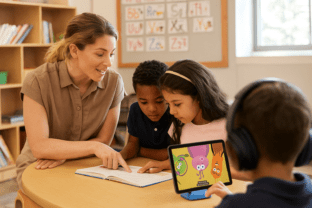As many schools are seeing results from the use of educational technology in the classroom, others are tirelessly hunting for iPad funding and grants for schools to make similar programs a reality. With declining public school funding and budget cuts, hardships are inevitable when attempting to implement such expensive initiatives.
For those willing to put the time and energy in, applying for additional state, local, and federal grants for schools opportunities may help secure additional room in your district budget for hardware and software solutions.

What are grants for schools?
Grants are streams of funding offered by a government body or an organization. The three main types of grants for schools are:
- Block grants – Federal funding allocated to states for a particular purpose
- Formula grants – Provide funding on the basis of a specific formula determined by Congress (i.e. Title 1 Funding)
- Project grants – Competitive grants given to support individual projects in accordance with legislation. These are competitive to obtain as the funding agency has complete discretion in selecting the sponsored project, grantees, and amount of the grant award.
Types of Funding
- Public Funds – Obtained from governmental units, such as federal, state, and local agencies
- Private Funds – Come from organizations involved in charitable giving, such as foundations, direct giving programs, voluntary agencies, and community groups

Examples of Public Funding:
Title I: The purpose of this title is to ensure that all children have a fair, equal, and significant opportunity to obtain a high-quality education and reach, at a minimum, proficiency on challenging State academic achievement standards and state academic assessments.
21st Century Learning Models: The purpose of the 21st Century Learning Center is to provide opportunities for communities to establish or expand activities in community learning centers.
School Improvement Grants: Grants to State Educational Agencies (SEAs) that SEAs use to make competitive subgrants to Local Educational Agencies (LEAs) that demonstrate the greatest need for the funds and the strongest commitment to use the funds to provide adequate resources in order to substantially raise the achievement of students in their lowest-performing schools.
IDEA, Part B: The purpose of this part of the Individuals with Disabilities Education Act is to ensure that all children with disabilities have available to them a free appropriate public education that emphasizes special education and related services designed to meet their unique needs and prepare them for further education, employment, and independent living.
English Language Acquisition State Grant: This program is designed to improve the education of limited English proficient (LEP) children and youths by helping them learn English and meet challenging state academic content and student academic achievement standards.
Examples of Private Funding:
Foundation Grants: Private foundations generally receive funding from an individual, family, or group of individuals. The grant funding priorities of private foundations are usually based on the personal philosophies of the founding members. For example, the Bill & Melinda Gates Foundation, founded and supported by Bill and Melinda Gates, aims to expand educational opportunities and access to information technology. We even won a grant from this foundation to fund eSpark’s efficacy research!
Corporate Grants: Corporate foundations generally receive contributions from a profit-making entity, such as a corporation, and give grants for schools for programs aligned with the parent corporation’s mission or core values.
Voluntary agencies: Voluntary agencies support charitable programs that are consistent with their overall mission. (e.g. American Red Cross)
Local organizations: Local organizations offer funding to support projects within their communities and may be worth exploring.
There are many grants for schools out there that cover more than just the cost of hardware and software—a common misconception is that grant funding will only get you as far as purchasing the iPads themselves. In reality, iPad grants are available to help cover the cost of technology training, curriculum, telecommunications, and even professional development if your public school funding isn’t cutting it. It’s important to remember that purchasing iPads is only the first step of implementing technology into your classroom—there’s a lot more that must be done to make them effective learning devices.
See how eSpark can make an impact in your classrooms by signing up for free today.



